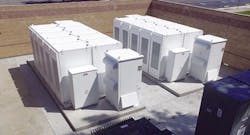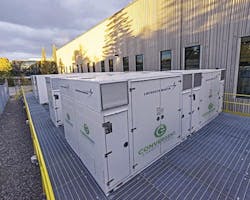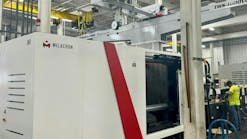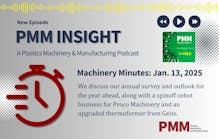Trying to wring savings from utility bills can be wearying, but there are ways to recharge. For some companies, plugging into batteries might do.
As Husky Injection Molding Systems Ltd. and processor Universal Plastic Mold Inc. (UPM) become the latest plastics industry companies to adopt energy-storage systems, makers of the technologies say they represent a cost-effective, low-risk strategy to manage electricity consumption. At times of peak demand and greatest expense, the systems automatically reduce plants' energy draw from the grid, using batteries as backup.
Gabe Schwartz, marketing director of Stem, a California-based energy-storage supplier, said timing is everything. The physical aspect of the system — advanced lithium batteries — is straightforward; it's what's in the cloud that matters. For Stem, that's Athena, a continuously updated, self-learning software platform that determines when switching off the grid makes the most sense for users, based on consumption and individual utility rate structures.
"The system is always paying attention to when is a really bad time to buy electricity," Schwartz said. "Anytime that's not that time, it's going to be charging up the batteries."
Any heavy users of electricity, including plastics industry manufacturers, can potentially benefit from energy-storage systems, said Oscar Araujo, senior VP of Convergent Energy and Power, which recently installed a system for Husky. Both he and Schwartz said their companies assess facilities' energy consumption and costs to determine whether energy storage makes sense for them. "As a general rule of thumb, if your process is electricity-intense, you have a large electricity demand on your facility, and electricity rates are high in your area, energy storage most likely will be able to reduce your electricity bill," Araujo said.
Location also is key to determining whether the systems might be advantageous. That's because costs vary so widely. In some places, utilities are increasingly reining in demand by determining costs by time of use, rather than simply quantity of consumption. For example, Bolton, Ontario-based Husky pays far more for load-based costs, called Global Adjustment fees, than it does for pure consumption, said Robert Meek, the company's director of global facilities. Once operations begin for its Convergent Energy and Power installation at its 54-acre, five-facility plant, it anticipates a 60 percent reduction in those charges.
"Battery storage systems provide additional financial benefit by enabling the company to manipulate its consumption patterns to take further advantage of favorable off-peak electricity rates to reduce commodity charges," Meek said.
The situation is similar in the Los Angeles area, where UPM, a Stem client, is located. Specializing in large parts, UPM operates 32 molding machines at its plant in Baldwin Park, Calif. It is anticipating the installation of an energy-storage system sometime in the very early part of this year, company President Jason Dowling said.
California's overstretched grid, and surcharges for using energy at peak periods, provide incentives for adopting a battery backup, he added. So do rebates that users can receive for reducing usage during energy crunches, such as those caused by the recent fires or extreme heat.
From replacing machines to studying natural gas and solar power, Dowling said his company long has had a deep interest in reducing its power consumption. Stem's proposal was a no-brainer: The company approached him, explained how much UPM stood to save and offered the batteries and use of Athena at a fixed rate, as part of a 10-year agreement.
"With the Stem program, from Day 1, you start saving money," Dowling said. In addition to lowering costs, UPM's new system will qualify for rebates under California's Self-Generation Incentive Program, which is designed to encourage utilities customers to take advantage of new technologies that reduce pressure on the grid.
To keep up with changing rate structures and incentives, Schwartz said Stem employs teams of data scientists, as well as experts specializing in rates, utilities and government policies.
The artificial intelligence that drives Athena and ultimately decides the most advantageous periods in which to shuttle some of the power burden to batteries is regularly updated by software developers.
"Their job is to be continuously making the software smarter," said Schwartz, who cited, as an example, updates that reflect incentives from utilities for reducing energy use during certain periods.
Schwartz described the process the software uses to manage when the batteries are used and how it responds to these periods of on/off-operations. At times, he spoke about Athena as one might a human.
"What she's doing, she's constantly looking for valuable uses for that downtime," he said.
When not in use, the batteries are recharging, using power from the grid or other sources, such as on-site generation or solar cells.
"In some cases, our Athena platform will intentionally charge the batteries when a customer's solar system is producing power, either to comply with tax-incentive programs or to avoid selling excess solar power back to the grid at too low a price," Schwartz said.
At UPM, Dowling said Athena will be set up to transfer some energy use from the grid to batteries during peak periods. Previously, he said, peak-period reduction had been a manual process, with workers flipping off the lights and shutting down machines. With UPM's emphasis on saving energy, Dowling said he especially appreciates the insights into factory operations he'll gain from Athena.
Over the last 10 years, Dowling said UPM has made special efforts to replace machines and retrofit some energy bill-busters, such as lighting and air compressors. In the last year or so, he said the company replaced a 1980s-vintage Engel injection molding machine with a brand-new 2,000-ton Milacron hybrid to save energy costs, reducing by 85 percent the energy use of that cell. Dowling acknowledged, however, that remaining competitive while working in southern California is a demanding endeavor. That's why he's interested in any energy-efficiency project that comes his way.
"Even with all those things, we've seen a half-percent increase [in energy costs]," he said. According to information that Stem provided to him, he expects to enjoy savings immediately by using a 264-kilowatt energy-storage system controlled by Athena. Over 10 years, UPM's gross savings will total $497,000, according to projections. The company's investment in the same timeframe will be $245,000.
As part of setting up a new system, Schwartz said Stem looks at an entire year's worth of bills for the client, analyzing 15-minute increments of its energy consumption. This process enables the company to assess both the appropriateness of energy storage and the size of the system that's needed. Typically, he said, systems provide 20 percent to 40 percent of the power during peak-load periods.
"We do have customers that save two to three times what they pay us, and that is enabled by right-sizing the system," he said.
Users experience little to no disruption when energy-storage systems are installed, Schwartz and Araujo said. "Our solution does not interfere with the operation of the facility," Araujo said.
Besides saving users money, Schwartz cited a number of other benefits of the systems. By relieving stress from the grid, they buttress the power supply for all other users. This also helps compensate for the unpredictable supply coming from alternative energy sources, such as solar power and wind, as they are added to the grid.
One additional benefit is less tangible, but of certain appeal to manufacturers interested in touting their technical prowess.
"Not many plastics manufacturers can say that they optimize their energy use in real time, using artificial intelligence," said Schwartz, noting that so far, Stem has worked with only about a dozen companies in the industry.
Controlling costs in a tough market just might require being on the cutting edge. But staying in sunny southern California is important to Schwartz, which is why he's committed to continuing to innovate.
"I think it will be an ongoing thing forever," he said. "We don't anticipate energy costs coming down."
For more information
Convergent Energy and Power LP,New York, 917-508-0190, www.convergentep.com
Stem Inc.,Millbrae, Calif., 415-937-7836, www.stem.com
Karen Hanna, copy editor
Karen Hanna | Senior Staff Reporter
Senior Staff Reporter Karen Hanna covers injection molding, molds and tooling, processors, workforce and other topics, and writes features including In Other Words and Problem Solved for Plastics Machinery & Manufacturing, Plastics Recycling and The Journal of Blow Molding. She has more than 15 years of experience in daily and magazine journalism.







